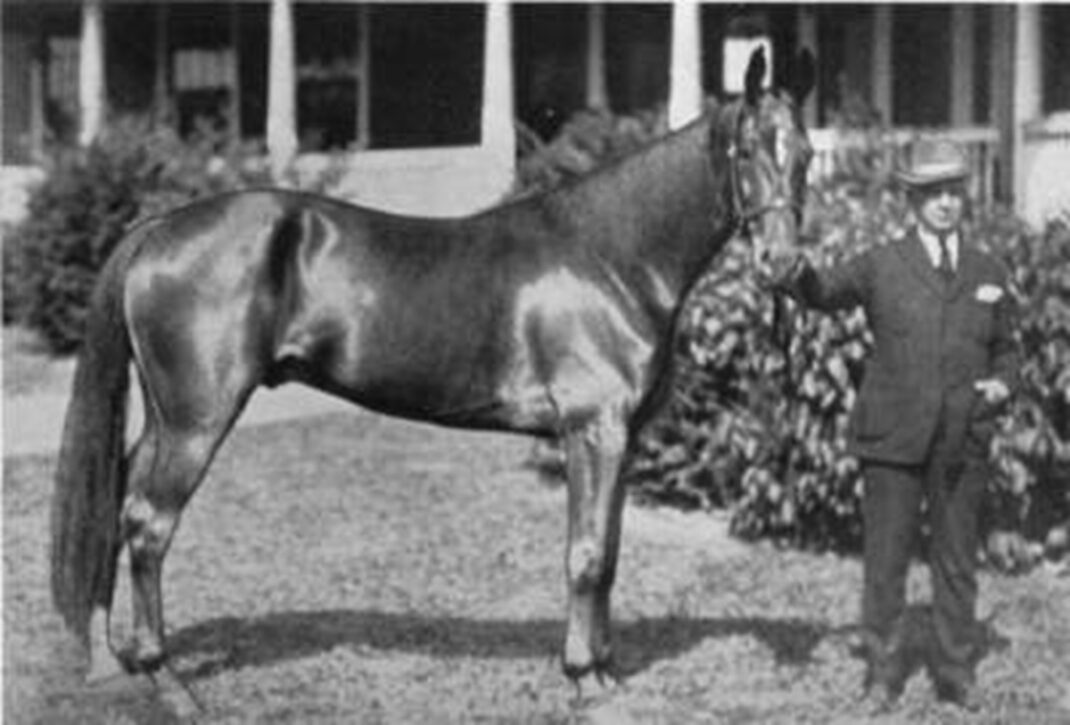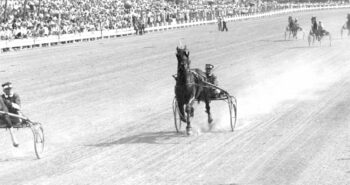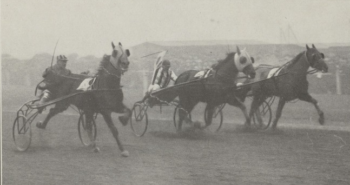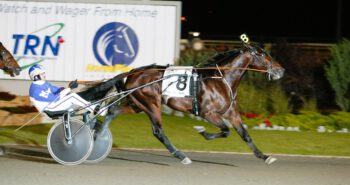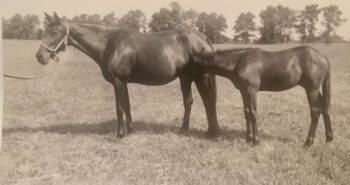He was the world’s first 1:56 trotter and a prized possession of Lawrence Sheppard’s fledging Hanover Shoe Farms. Peter Manning was a natural talent who improved quickly with little work. In fact, the legendary gelding was so good it required a horse of Greyhound’s caliber to beat his world record.
William Monroe Wright, chairman of Chicago’s Calumet Baking Powder, initially raised trotters more as a diversion, occasionally racing one or two. From his friends FE Marsh, owner of the Grattan Farm near Chicago, he purchased a young mare called Glendora in 1908. She was a very fast mare, able to trot in 2:15 (1.23,9) but had soundness issues and ended up taking a record of 2:25 3/4 (1.30,6). Wright then bred her to juvenile champion Azoff 2,2:14 1/4 (1.23,4), owned by another Chicago friend. The first Azoff-Glendora mating was a filly, supposedly of wonderful speed but injured early. Repeating the breeding, the second product was a colt named Peter Manning born 1916. Wright then put Glendora up for sale at an auction in Chicago.
So much speed with so little work
In 1918, Peter Manning had been advertised for sale for $100, but nobody fancied the two-year-old enough to buy him. According to an article in the Pittsburgh Daily Post on Oct 5, 1919, Peter Manning was broken to harness in April that year by his trainer Harry Putnam and trotted his first 2:30 (1.33,2) mile in training in July. Making his first start in Libertyville in August as a 3-year-old, he won in 2:17 1/4 (1.25,3). At the Wisconsin State Fair at Milwaukee a month later he ran a time trial in 2:10 (1.20,8). He was initially entered into the Kentucky Futurity, but Putnam and Wright felt the horse was insufficiently prepared to handle three demanding heats so early in his career. Instead Peter Manning ran against the clock on Oct 4 where he equaled the world record for 3-year-old geldings when he trotted 2:06 1/2 (1:18.6), that record having been set by Easton a year earlier. What was particularly impressive was that Peter had ran the last half in 1:00 1/2 and the last quarter in 29 1/4.
Later that Lexington meeting, trainer Thomas W Murphy, acting on behalf of Irving Gleason, paid a reported $21,000 for Peter Manning who, at that point, had not won anything of interest, only ran a fast time trial. Murphy decided to work Peter Manning in a mile himself too, wanting to get a feel for his newly acquired trotter. Without being pushed Peter Manning trotted in 2:12 1/2 (1.22,3) with the last half in 1:01 1/2 and the final quarter in 30 seconds flat. Murphy remarked that he had never driven a quarter in that time with such ease. As observers noted, no trotter had ever shown so much speed with so little work. Peter Manning was a true natural talent.
Breaking world records
Next spring Murphy reported that Peter Manning had trained well throughout the winter, and that he was expecting the gelding to have a great season. His expectations would be fulfilled. On the North Randall track in Cleveland on Aug 12, 1920, the 4-year-old Peter Manning set his first world record, this one for three heats for 4-year-old geldings, trotting the heats in 2:04 3/4, 2:03 1/2 and 2:08 (1.17,5, 1.16,8 and 1.19,6). In Lexington on Oct 7, he lowered that record further to 2:03, 2:02 3/4 and 2:02 1/2 (1.16,4, 1.16,3 and 1.16,1). He failed to finish in the money in the Minoga Stock Farm Purse in Philadelphia six days later, a race won by E Colorado, but it was really a case of equipment failure as his check rein broke in the second heat. The opponent’s joy proved short-lived as Peter was back to his winning ways the following week.
He won all other races that season, finishing the 1920 season with 10 wins in 11 starts and seasonal earnings of $26,550. Despite that, he didn’t immediately win over all doubters. An article written by WM Burgett in the Pittsburgh Daily Post on Oct 17, 1920 summed it up: “To my mind Peter Manning won the big classic so easy that he overshadowed his field, and how any of the followers of the other horses ever got it into their heads that Nedda could beat him is a question, and I frankly confess that I was one of the great number that thought Nedda had a chance to trim the Reading gelding.” It bears mentioning that Nedda in her career won 23 of 43 races, was a 1:58 1/4 (1.13,5) trotter and one of the best, if not the best, race-mares of her time. Yet in the end, Peter Manning had her number and more.
The scientific study
Yet even greater things were on the horizon for Peter Manning. But as the gelding kept breaking records and making it abundantly clear that he was capable of lowering Uhlan’s 1:58 (1.13,3) world record, breeders and horse people started studying his pedigree and wondering where his speed came from. In early November 1921, a professor published a study of pedigrees that concluded that Peter Manning’s ability from speed comes from Axworthy. Published in many newspapers on Nov 15, 1921, the first part of the the article read “A study of pedigrees made by Prof WS Anderson, an authority on horse breeding and a member of the animal husbandry department of the Kentucky College of Agriculture, shows that the two animals derived their ability for speed from Axworthy, a sire who was not exceptionally fast himself, but one who is noted for the speed of his get and that of his sons. He has a record of 2:15 1/2 (1.24,2). Studies made by Professor Anderson show that Peter Manning (…) could not have obtained his speed from his mother Glengora G, who had a track record of 3, 2:25 3/4 (1.30,6), nor from her sire Emmett Gratton, who had a record of 2:28 (1.32).”
Not that much is known about Peter’s dam Glendora G. However, the professorial conclusion that Peter Manning’s speed could not possibly have come from her, while appearing sensible when looking at her record, seems to be a conclusion made without looking at all the facts. Glendora G was reportedly a fast mare, though she never bred anybody else of note. Her granddam Wallie More, was the full sister to Gambrel, a 2:10 1/2 (1.21,1) trotter born 1887. There is, however, one known story about Glendora G which makes it easy to think that Peter got a quite a bit of ability from her. According to the story, retold in the Brooklyn Daily Eagle on Nov 5, 1922: “Mr Wright told his young nephew to lead the mare over to John R Thompson’s farm where Azoff stood stud. The boy knew quite some about automobiles but much less about horses and he tied Glendora to the tail of his machine and started out to tow her on the four-mile trip. The boy had heard his uncle say that Glendora G could trot a 2:00 clip and the idea that the machine might help her along came in the youngster’s mind. Marsh, who had owned Glendora, happened to be on the lawn of his place as they passed midway between the Wright and Thompson farms. The boy had opened up the machine and the mare, fastened on in the rear, was wrotting for her life with the halter pulled to the limit. Mr Marsh realized in a second what was happening and went to the telephone and called someone up to intercept the driver but he had already gone by the farm. Then he got in touch with the Thompson farm two miles further on expecting to learn that Glendora G had died in her tracks but found that she had arrived there but completely overcome in her four-mile race paced by the motorcar. Glendora was bred to Azoff and Peter Manning was foaled the next spring.”
Race of the Century
Regardless of the origins of Peter Manning’s abilities, he set his sights to further terrorizing his opponents. So did his trainer Thomas Murphy, after rejecting offers of $45,000 in the beginning of 1921. But would he be allowed to even race? In March came the message that Peter Manning had been barred from the North Randall Purse of $15,000, one of the largest ever offered at a Grand Circuit meeting. The reason was that Peter was “believed to outclass every trotter in training.”
In Cleveland on Aug 9, 1921, Peter had to settle for running against the time, setting a new world record for 5 year-old-geldings with 2:00 1/4 (1.14,7). This was 2 seconds faster than Uhlan did at the same age. With Peter Manning banned from regular races and unable to make money, the idea of a match race with pacer Single G was aired on August 14. Five days later WH Gocher, secretary of the National Trotting Association, announced he had arranged a 2-heat race against time between Peter Manning and Single G at the Hartford Grand Circuit meeting on Sept 6, with a $5,000 purse put up. While most newspapers ran headlines like “Peter Manning to meet Single G”, the Evening Public Ledger went a step further and put “Race of the Century” as the title on their article. A few days later it was also reported that Peter’s owner Irving W Gleason and Single G’s owner William B Barefoot had placed a side bet of $10,000.
Peter warmed up to the affair by time trialing in 2:00 at Reedville. The “race of the century” proved a massive disappointment, though. Peter Manning took both heats in 2:02 1/2 (1.16,1) and 2:06 (1.18,3). In fact, the association was so unhappy with the performances of Single G that they hired a Hartford lawyer to investigate – though that came to nothing. In Syracuse, on Sep 15, Peter time trialed again, now going for Uhlan’s world record. He equaled Uhlan’s 1:58 (1.13,3) record and around this time Thomas Murphy issued a challenge to race Single G again for a side stake of any amount from $10,000 to $100,000, winner take all, at the Grand Circuit in Lexington. On Sep 23, Peter Manning demolished the Columbus track record of 2:01 (1.15,2), set by The Harvester, when he trotted in 1:59 1/4 (1.14,1). Six days later he lowered his own mark to 1:59 (1,14) flat.
Beating Uhlan’s record
As Peter Manning’s legend grew, so did his breeder’s interest in reacquiring the speedy gelding. At the end of September William M Wright offered $50,000 for Peter Manning, wanting to buy back the horse he sold for $21,000 two years earlier. However, the offer was refused.
Murphy just focused on Uhlan’s 1:58 (1.13,3) world record and knew the fast track at Lexington would be the perfect place to lower it. Having a go at it on Oct 6, 1921, driven Murphy himself, Peter Manning opened the first quarter in 30 and came to the half in 59 1/2. Even though this was a bit slow the spectators knew that Peter had the ability to finish strong, so when he went by the three-quarter pole in 1:29 there was still some hope. However, doing so required a 28 3/4 or faster last quarter, a big ask. Still, when Peter flashed under the wire he managed just that, going a 28 3/4 last quarter to lower the world record to 1:57 3/4 (1.13,2). Uhlan’s nine year old record was finally broken.
Peter tried to lower his world record again in Atlanta, GA but could “only” manage 1:59 3/4 (1.14,4) at the Lakewood racetrack. It was not for lack of trying though, The Atlanta Constitution describing it as “Peter Manning makes glorious effort to lower trot record”. Delving into the facts, Peter got away terribly and the first half was done in 1:02 3/4 while the last half was completed in a fantastic 57 seconds and more fantastic, the last quarter was completed in 27 1/2 seconds – a 1:50 mile equivalent. Not bad by today’s standards, but mind-blowing in the 1920s.
The next year Peter Manning would lower his record to 1:57 (1.12,7) on Oct 6th at Columbus but only two days he would lower it again to 1:56 3/4 (1.12,6). This record would stand for 15 years when it was first equaled, then lowered, by Greyhound in 1937. Not welcome in regular purse races, Peter ran time trials, breaking the track records almost everywhere he appeared.
Bought for the prestige
As Peter Manning’s fame and reputation grew, so did WM Wright’s desire to devote more time to his passion for trotting. Having made fortune on his Calumet Baking Powder Company, Wright transferred his business to his son Warren and in 1924 purchased Fairland Farm from Captain HJ Schlesinger, Milwaukee and renamed it Calumet Farm. He also purchased the stallion Belwin from the same person for $50,000 and Schlesinger’s 13 broodmares for another $50 000, then the stallions Peter the Brewer and Justice Brooke, plus it was also reported that he in 1924 spent another $275 000 on other broodmares. Wright also bought back Peter’s dam Glendora G and gave her a home at Calumet until she died in 1930. In 1927 it was estimated that the total investment made by Wright on horses, equipment and buildings at Calumet Farm exceeded 2 million.
However, Peter Manning didn’t end up at Calumet. In 1926 he was sold to Hanover Shoe Farms and trotted many exhibition miles, primarily in Pennsylvania. Even though he was past his prime and, being a gelding, useless for breeding purposes, owning a horse of Peter Manning’s name gave prestige to Hanover itself. Peter Manning was then retired and died at Hanover Shoe Farms on February 28, 1943 at age twenty-seven.
Peter Manning
Bay gelding born in Libertyville, IL in 1916. Died in Hanover, PA on Feb 28, 1943.
Azoff – Glendora G (Emmett Grattan)
1:56 3/4 (1.12,6)
Breeder: William Monroe Wright
Owners: William Monroe Wright – Irving Gleason – Hanover Shoe Farms
Trainers: Harry Putnam and Thomas W Murphy
Drivers: Harry Putnam and Thomas W Murphy
Groom: –

